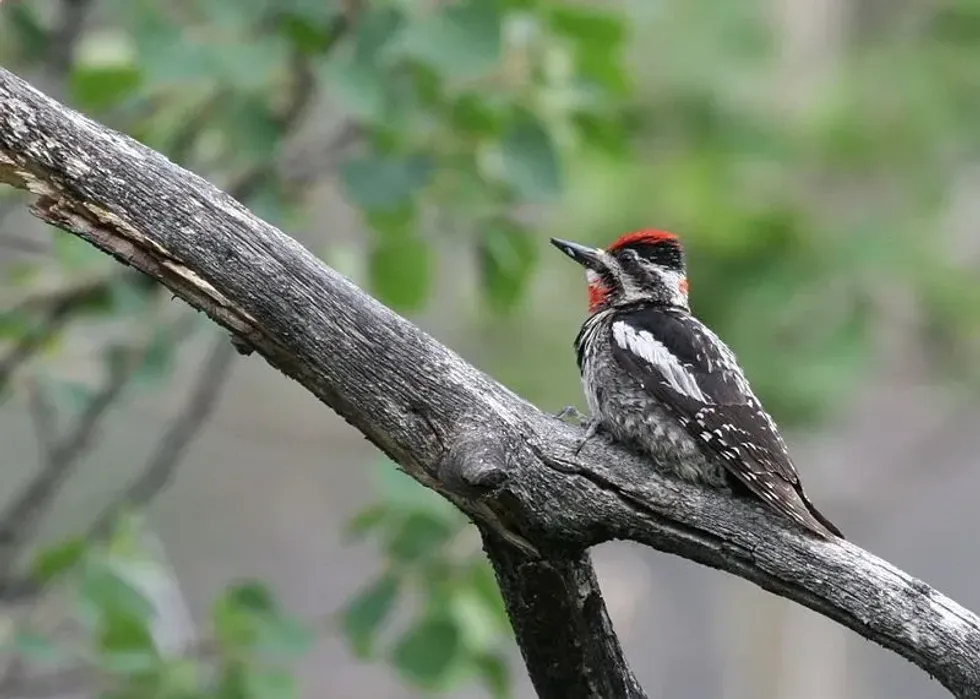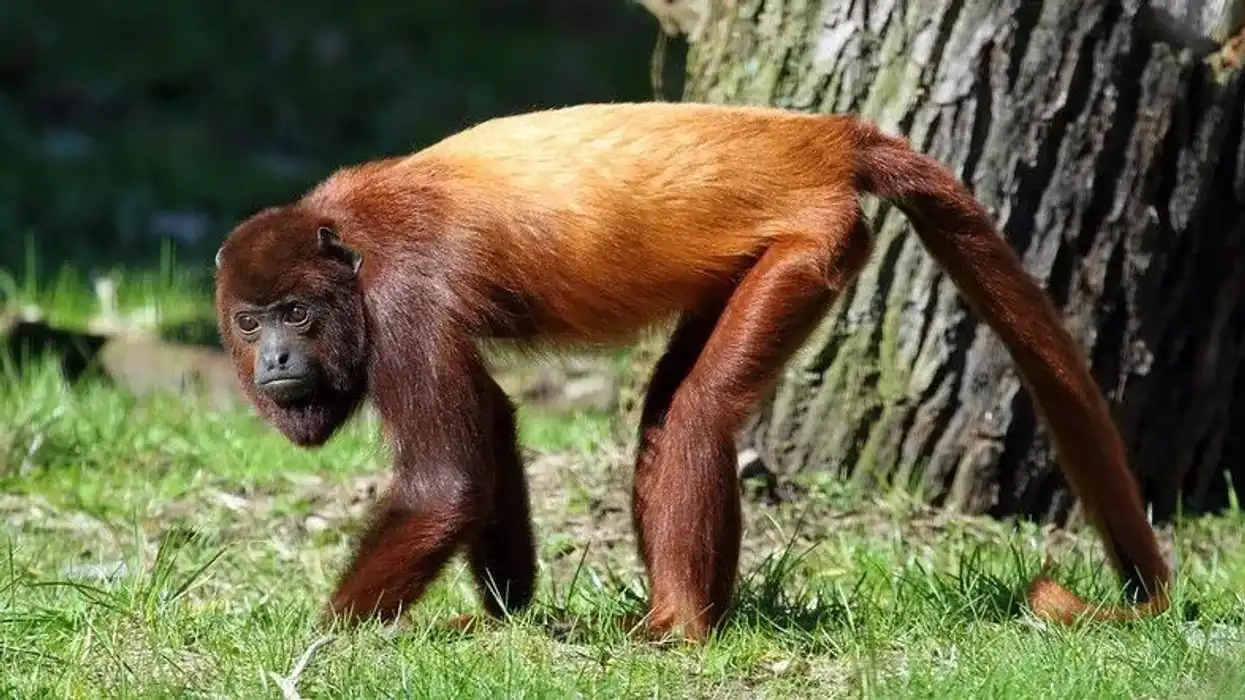The Red-naped Sapsucker, Sphyrapicus nuchalis as it is scientifically known, belongs to the Picidae family. It is a medium-sized woodpecker and its Red Naped Sapsucker range map is based in North America.
It is found in the Great Basins and Rocky Mountains region or the area. It is also known as the North American woodpeckers as these birds belong to the family of woodpeckers.
They are close relatives to the yellow-bellied and red-breasted sapsuckers as they are similar species. The scientific name 'Sphyrapicus' is derived from the Greek words 'Sphura', which means 'hammer', and 'Pikos' meaning 'woodpecker', while the word 'nuchalis' is a Latin word meaning 'of the nape'.
This bird is black and white and has red patches on the throat.
The habitat of these birds can differ in the winter season and the habitat includes pine-oak trees, orchards, aspen, and forest edges. During the breeding season, these birds chase to find mates and nest in holes or sap wells in trees.
As the name suggests, these birds feed on the sap and the insects found in the tree sap. The Red-Naped Sapsucker female does not have a red patch on the throat like the males.
The juvenile Red-naped Sapsucker looks similar to adults. Read on to know about this species and if you are interested, read about doves and owls too.
Red-Naped Sapsucker Interesting Facts
What type of animal is a Red-Naped Sapsucker?
The Red-Naped Sapsucker, Sphyrapicus nuchalis, is a bird.
What class of animal does a Red-Naped Sapsucker belong to?
Red Naped Suckers belong to the class of Aves of birds.
How many Red-naped Sapsuckers are there in the world?
There has been no specific number of these Red-naped sapsuckers recorded.
Where does a Red-naped Sapsucker live?
These Sapsuckers live in forests in North America, in the Rocky Mountains and Great Basins areas.
What is a Red-naped Sapsucker's habitat?
These birds are known to breed in evergreen and deciduous forests with willow, birch, aspen, juniper, or Douglas fir trees. The appropriate elevation is 1000-10,000 ft.
These birds can be seen breeding in gardens, yards, and heightened forest edges habitats. These birds do not prefer oak or pine forests during breeding but tend to migrate to these forests and orchards and woodlands in winter.
Who does Red-naped Sapsucker live with?
These birds breed in groups and can also be seen individually.
How long does a Red-naped Sapsucker live?
These birds are known to live for about two to three years.
How do they reproduce?
These birds breed once a year. During the beginning of the spring, these sapsuckers chase potential mates and produce loud calls, and courtship rituals or displays include pointing bills to show the color on the throat and tapping the nest sites.
Nest sites include cavities in some dead trees and other deciduous trees like aspen at a good elevation. These trees are often used in the years ahead and sometimes also use the same hole or sap well.
These birds prefer live trees with decay fungus. Both males and females excavate these nests.
Between three and seven white eggs are laid and the incubation period lasts for about 10-13 days and incubation is done by both the parents. The feeding of the young is also done by both parents.
The young can fly and leave the nest after about 25-29 days of hatching. The young ones are altricial, naked, and helpless when born.
What is their conservation status?
The conservation status of these birds is ‘Least Concern’.
Red-Naped Sapsucker Fun Facts
What do Red-naped Sapsuckers look like?
These birds are known to be medium-sized birds or woodpeckers. These birds have a black colored head and a red forehead and have white stripes.
It has a red-colored spot on the nape and thus, the name.
The upper belly and the breast are yellow-colored which is also passed on to the shoulders and the rump and the lower belly are white and tend to have a stiff tail.
The body or the back is also black and has visible white stripes or bars and a large patch on the wings. The difference between adult males and females is that males have a red throat patch while a female Red-naped Sapsucker has a red color patch or spot on the lower part of the throat.
How cute are they?
Some people consider this bird cute because of its colorful body.
How do they communicate?
Not much information is available about the communication of these birds.
How big is a Red-naped Sapsucker?
Red-Naped Sapsuckers are known to be similarly sized to robins. These birds are larger than a Downy woodpecker and can be smaller than a Northern flicker. These birds can be 7.5-8.3 in (190.5-210.8 mm) long.
How fast can a Red-naped Sapsucker move?
The exact speed of these North American birds or woodpeckers is unknown.
How much does a Red-naped Sapsucker weigh?
These North American birds or woodpeckers can weigh around 0.07-0.14 lb (0.032-0.066 kg).
What are the male and female names of the species?
There are no specific names for the males and females of the species.
What would you call a baby Red-naped Sapsucker?
There is no particular name for a baby of these species and they are generally referred to as young or offspring.
What do they eat?
These birds eat the tree sap and the insects like the ants on the sap and other flying insects too. They also feed on berries and fruits.
Are they poisonous?
These birds are not poisonous and are not considered harmful to humans.
Would they make a good pet?
Not much information is available about these birds as pets, but given their habitat preferences for forests, it may be best to leave them in their natural habitats.
Did you know...
Red-Naped Sapsuckers are closely related to the Red-Breasted Sapsucker and Yellow-Bellied Sapsucker and all these three species were initially considered to be races of the Yellow-Bellied Sapsucker.
Interbreeding of these birds happens with the Red-Breasted Sapsuckers in the west of the breeding range and with the Yellow-bellied sapsucker in the eastern part of the breeding range and it is quite difficult to differentiate or identify the Red-Naped Sapsucker hybrid.
The tongues of the sapsuckers are shorter than that of the woodpeckers and have short hair-like projections that help them to eat saps.
These birds fly in a swinging manner or pattern and alternate between flaps and glides.
The nest of this bird is around 1.5 in wide and 1.5 in tall.
A group of sapsuckers is known as a slurp of sapsuckers.
What is the difference between a Sapsucker and a Woodpecker?
Sapsuckers belong to the family of woodpeckers. The difference between both of them is that the sapsucker makes small holes in the trees and voraciously damages the trees with its bill while the woodpecker pecks the tree and feeds on the insects on the barks of trees that are already damaged or distressed.
Where do Sapsuckers nest?
Sapsuckers nest in holes of life and some dead trees, although they prefer holes in live trees. The trees include aspens, Douglas fir, and black cottonwood.
Here at Kidadl, we have carefully created lots of interesting family-friendly animal facts for everyone to discover! Learn more about some other birds including eagles and hawks.
You can even occupy yourself at home by drawing one on our red-naped sapsucker coloring pages.









